Panel summaries
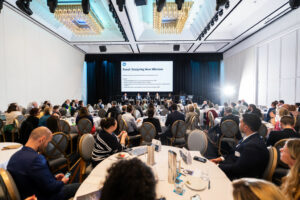 The Summit provided a valuable opportunity to explore broader applications for mission-oriented innovation in Australia and its value as a mechanism for addressing complex national challenges, and encourage others to collaborate with CSIRO and adopt mission-directed approaches.
The Summit provided a valuable opportunity to explore broader applications for mission-oriented innovation in Australia and its value as a mechanism for addressing complex national challenges, and encourage others to collaborate with CSIRO and adopt mission-directed approaches.
Revisit highlights or catch-up on what you missed from the range of panels that took place at the Summit.
Panels
Open allClose all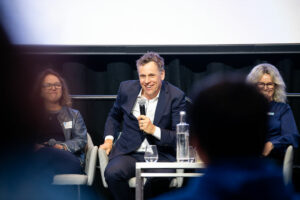
Dr Krispin Hajkowicz, Director- Infectious Diseases Unit, Royal Brisbane and Women’s Hospital
Moderator: Janine Walker AM, Chair, Metro South Health
Panelists:
- Professor Daphne Flynn, Director Design Health Collab, Co-Lead Future Healthcare, Monash University
- Dr Krispin Hajkowicz, Director- Infectious Diseases Unit, Royal Brisbane and Women’s Hospital
- Dr Branwen Morgan, Mission Lead, Minimising Antimicrobial Resistance Mission, CSIRO
- Professor Trent Munro, Australian Institute for Bioengineering and Nanotechnology, University of Queensland
The panel discussed the urgent need for innovation and collaboration in healthcare to ensure access to high-quality healthcare for all Australians, regardless of location or financial situation. There was an emphasis on collaborative problem-solving with end users/patients at the start and a shift away from tech push to designing problem-focused solutions.
Key takeouts:
- Measuring Health: The importance of measuring health outcomes using various metrics, such as infant mortality rates, road safety, and healthy behaviours. They emphasised the need for clear, time-bound, coordinated missions to improve healthcare accessibility.
- Antimicrobial Resistance (AMR): The global challenge of AMR causes many deaths worldwide. The panel stressed the importance of awareness, action, and accountability in addressing this issue and setting concrete, time-bound goals.
- Innovation and Collaboration: The role of innovation and research in solving healthcare challenges. They discussed the need for collaboration and data sharing among healthcare professionals and institutions to drive progress.
- Chronic Disease Management: The recognised need to shift focus from acute care to chronic disease management and the importance of considering the patient journey and value-based pricing in healthcare.
- Data Sharing and Privacy: The challenges of sharing and protecting healthcare data. While data sharing is crucial for precision healthcare, privacy concerns must be addressed to ensure ethical and secure data usage.
- Engaging First Nations Communities: The importance of co-designing solutions and listening to lived experiences, highlighting successful examples of engaging First Nations communities in healthcare initiatives.
- Data Reform: Structural silos and a lack of advocacy for data reform were identified as barriers to progress. The panellists stressed the need for a top-down and bottom-up approach to break down these barriers and promote data reform.
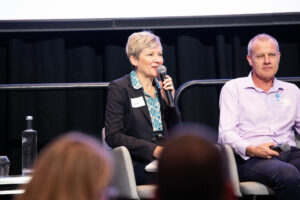
Dr Nicole Garofano, Head of Circular Economy Development, Planet Ark Environmental Foundation
Moderator: Anna-Maria Arabia, Chief Executive, Australian Academy of Science
Panelists:
- Dr Adam Best, Mission Lead, Renewable Energy Powerhouse Mission, CSIRO
- Dr Nicole Garofano, Head of Circular Economy Development, Planet Ark Environmental Foundation
- Michele Graham, General Manager- Quantum Branch, Australian Department of Industry, Science and Resources
- Dr Crispin Howitt, Mission Lead, Future Protein Mission, CSIRO
The panel discussed collaboration, innovation, and government support as essential factors in developing and sustaining emerging industries in Australia. These industries are crucial in addressing global challenges and driving economic growth.
Key takeouts:
- Collaboration and Ecosystems: Building capacity and capability in emerging ecosystems involves reaching beyond traditional boundaries and fostering cross-industry conversations. Creating ecosystems around companies and industries can lead to spillover benefits, collaboration, and innovation.
- Government’s Role: The government is pivotal in supporting emerging industries like Quantum technology. This involves convening stakeholders, creating a national vision, and addressing information gaps. The government also needs to bridge gaps and address market failures to facilitate the growth of these industries.
- Engaging Young People: Encouraging young people to address global challenges requires promoting STEM education and showing clear pathways to impactful careers. Highlighting opportunities for meaningful contributions to environmental and societal issues can inspire young minds.
- Critical Minerals and Renewable Energy: Australia’s vast mineral resources, especially critical minerals, can contribute to the global transition to renewable energy. Initiatives like the Renewable Energy Powerhouse Mission (REP) aim to transform minerals into products, including manufactured batteries while ensuring secure, reliable, and affordable energy for the nation. Australia’s role extends beyond national boundaries to support the global energy transformation.
- Future Protein Mission: The Future Protein Mission recognises the global challenge of sustainably meeting the growing demand for protein. Australia aims to focus on its strengths and tap into the growing South East Asian market. The mission encompasses three work packages: Animal Protein, Plant Protein, and Novel Protein. These packages work together to create innovative solutions, such as upcycling food waste, and to address the challenges of a competitive food industry.
- Circular Economy: Transitioning to a circular economy is essential for sustainability. Design, durability, and longevity in product design are critical principles. Collaboration across supply chains is essential to address challenges like climate change effectively. A circular economy can create new business models and opportunities by disrupting traditional consumption patterns.
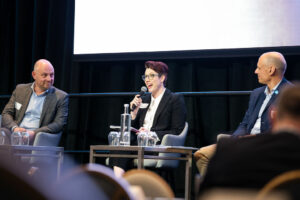
Tara Gardiner, Executive Director- Energy Supply and Storage, Department of Energy and Public Works (Queensland)
Moderator: Emeritus Professor Roy Green, Special Innovation Advisor, University of Technology Sydney
Panelists:
- Brenton Caffin, Executive Director Strategy and Policy, Department of Premier and Cabinet (South Australia)
- Dr Stephen Craig, Mission Lead, Smart Energy Mission, CSIRO
- Tara Gardiner, Executive Director- Energy Supply and Storage, Department of Energy and Public Works (Queensland)
- Dr Patrick Hartley, Mission Lead, Hydrogen Industry Mission, CSIRO
The insights from the panel underscore the need for collaboration, innovation, and community engagement in Australia’s energy transition.
Key takeaways:
- Energy Equity: Achieving energy equity involves innovative ownership models, data-driven decisions, and community involvement. Demonstrating localised benefits can garner community support for decarbonisation and energy transition.
- Global Inspiration: South Australia set ambitious goals earlier with solar and wind. They drew on a tariff model from Germany and lessons from Denmark; the 2016 severe weather event when the ‘lights went out’ was an opportunity to learn deeply about the problem, processes and batteries; harnessed talent and skills from universities in South Australia.
- Queensland’s Challenge: Queensland’s energy challenge is zero reliance on coal by 2035, and uptake of EVs has gone up through the roof, expected 30 times over by 2030. These present ‘real’ innovation challenges for Queensland – e.g., energy demands, solar uptakes and transforming an energy system built over many decades in just around 10 years. It’s a collaboration challenge. Coordination, creativity, and governance play out in the energy space.
- Systems Approach: Many interconnected parts need a structured piece and acknowledge that energy transition is systems engineering. Australia needs a stronger presence of systems engineering to be actively involved in energy transition. There is a need to cross-collaborate between non-traditional and traditional approaches. The mission construct will help integrate and transition from legacy structures, ‘turn things upside down’ and help in industrial transition.
- Hydrogen’s opportunity: CSIRO’s Hydrogen Mission has been applying the ‘missions approach’ and is now seeing a shift in government – e.g., working backwards and looking at the end goal. Highlighted the importance of having real champions and expanding to non-traditional areas. Organisations have many capabilities that can help missions. The key is to work together, deliver new ways to deliver goals and manufacturing opportunities and identify critical technologies.
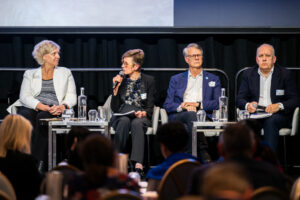
Dr Bronwyn Evans AM, Chair- Expert Panel, NSW Bushfire Response R&D Mission
Moderator: Professor Jenny Seddon, Deputy Vice-Chancellor Research, James Cook University
Panelists:
- Dr Michele Akeroyd, Deputy Mission Lead, Drought Resilience Mission, CSIRO
- Dr Bronwyn Evans AM, Chair- Expert Panel, NSW Bushfire Response R&D Mission
- Dr Alex Held, Mission Lead, AquaWatch CSIRO
- Mark Lamb, Chief Executive Officer, Murray Darling Association
The discussion highlighted the need for a holistic and proactive approach to address Australia’s environmental challenges while respecting local contexts and involving diverse stakeholders.
Key takeouts:
- Collaboration Challenges: Effective collaboration requires clear ownership and project management approaches to address complex environmental issues.
- Global Perspective: Environmental problems often have local and global dimensions, requiring a balance between addressing immediate concerns and understanding broader impacts.
- Local Relevance: Tailoring environmental solutions to the local level, considering social license and stakeholder readiness, is crucial for success.
- Resilience and Response: Building resilience and quick response mechanisms are essential, especially in bushfires and other environmental challenges.
- Data and Technology: Leveraging technology, data sharing, and rapid learning are vital for addressing environmental issues effectively.
- Balancing Interests: Balancing competing interests, such as water allocation, renewable energy, and biodiversity, requires a nuanced approach considering environmental, socio-economic, and community imperatives.
- Engaging Aboriginal and Torres Strait Islander communities: Engaging communities in environmental projects involves building long-term relationships, respecting indigenous knowledge, and fostering ownership.
- Regulatory Frameworks: Ensuring the right regulatory frameworks are in place, informed by evidence-based decision-making, is essential for sustainable environmental management.
- Science Implementation: Applying scientific research and listening to scientific predictions is crucial for effective environmental management.
- Future Agenda: Collaboration, innovation, and a focus on learning and reflecting on past successes are central to securing Australia’s environment.
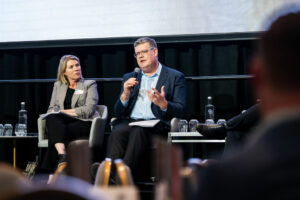
Nicole McNaughton, Chief Executive Officer, Food & Agribusiness Network & Dr Rohan Nelson, Agricultural and Natural Resource Economist, ABARES
Moderator: Steve Greenwood, Chief Executive Officer, Queensland Futures Institute
Panelists:
- Dr Ryan McAllister, Mission Lead, Trusted AgriFood Export Mission, CSIRO
- Nicole McNaughton, Chief Executive Officer, Food & Agribusiness Network
- Dr Rohan Nelson, Agricultural and Natural Resource Economist, ABARES
The panel expressed optimism about the future, driven by a growing interest in collaboration and innovative thinking within the agricultural sector in Australia and globally.
Key Takeaways:
- Agricultural Evolution: The Australian agriculture sector has transitioned through three distinct phases, marked by changing priorities and resource allocation over time. Consequently, agriculture’s innovation landscape has evolved from a state-based system to a more centralised and competitive approach, focusing on achieving specialisation and high returns on investment.
- Redefining Value: The panellists questioned the traditional definition of value in Australian agriculture, suggesting a more comprehensive perspective beyond gross production value. Concerns were raised about the implications of potential tariffs and protectionism on Australian agriculture, emphasising the importance of maintaining free trade.
- Multi-sector approach: Panellists discussed the challenges of moving away from single-sector solutions, emphasising the need for an economy-wide approach and the importance of technology and organisational aspects.
- Government’s Role: While acknowledging the government’s efforts, the panellists discussed the need for targeted support and a more integrated approach to government and governance. The discussion raised questions about the public sector’s role in driving innovation coordination in Australia, emphasising the need for innovative public involvement.
- Importance of Collaboration: Collaboration emerged as a central theme, focusing on fostering connections and opportunities within a collaborative ecosystem, particularly for small and medium-sized enterprises (SMEs) that often lack resources.
- Mission-Oriented Innovation: The challenges and opportunities of mission-oriented innovation were explored, highlighting the importance of impactful missions and market access through data-driven solutions.
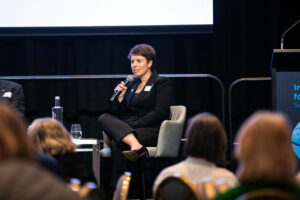
Amelia Olsen-Boyd, Executive Manager, Mission Strategy and Design, CSIRO
Moderator: Sam Buculo, Chief Executive Officer, Australian Design Council
Panelists:
- Dr Michael Battaglia, Mission Lead, Towards Net Zero Mission, CSIRO
- Professor Dan Hill, Director, Melbourne School of Design
- Professor Swee Mak, Associate Deputy Vice Chancellor (Research & Innovation Capability), RMIT University
- Amelia Olsen-Boyd, Executive Manager, Mission Strategy and Design, CSIRO
The panel discussion underscored missions are a vital tool for driving change, but they require a multidisciplinary, collaborative, and design-driven approach. Building leadership capabilities and embracing a culture of experimentation and flexibility are essential for successful mission outcomes.
Key takeouts:
- Design-Driven Approach: The significance of using design principles to inform scientific and technological missions. This approach involves defining clear mission objectives, embracing creative and visionary thinking, and continuously iterating the design process.
- Collaboration and Participation: Effective missions require collaboration with diverse stakeholders, including government, industry, academia, and the public. Collaboration creates a shared language and fosters a culture of participation, enabling the mission to evolve and adapt.
- Mission Characteristics: Missions differ from traditional innovation models, such as CRCs. They are normative, taking a position on what is in the national interest. Missions address challenges that may not have known solutions, requiring experimentation and flexibility to navigate complexity.
- Leadership and Capability Building: Developing leadership capabilities for missions is crucial. It is essential to identify emerging leaders within organisations and provide them with opportunities to learn and grow. Building soft infrastructure, such as networks and transdisciplinary thinking, is essential to support mission success.
- Expectation Management: Managing expectations regarding mission timelines and practical wins is important. Early wins, even small ones, can generate momentum and demonstrate progress. Mission design often involves combining immediate tangible actions and longer-term systemic changes.
- Purpose and Commitment: Clarity of purpose and a commitment to transformation are key drivers of successful missions. Organisations must recognise that business-as-usual approaches are insufficient for tackling complex challenges.
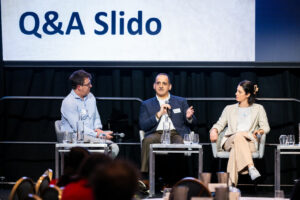
Professor Amro M. Farid, Alexander Crombie Humphreys Chair Professor in Economics of Engineering, Stevens Institute of Technology, Visiting Professor at MIT
Moderator: Ryan Winn, Chief Executive Officer, Australian Council of Learned Academies
Panelists:
- Professor Amro M. Farid, Alexander Crombie Humphreys Chair Professor in Economics of Engineering, Stevens Institute of Technology, Visiting Professor at MIT
- Peta Olesen, Director International Climate and Energy, Australian Department of Climate Change, Energy, the Environment and Water
- Andrea Sosa Pintos, Senior Program Manager, Indo-Pacific Plastics Innovation Network, CSIRO
The panel explored a wide range of themes related to international collaboration, highlighting its importance in addressing global challenges and the need for strategic, adaptable, and inclusive approaches to achieve meaningful outcomes.
Key takeouts:
- The Necessity of Collaboration: Many global challenges are too large for any nation to tackle alone. International collaboration is essential to address these complex issues effectively. Stressed was the “why” of international collaboration, highlighting global problems like climate change and energy transition demand collective efforts. Expressed was the need for equity, diversity, and inclusion in leadership and decision-making to address complex global challenges comprehensively.
- Geopolitical Considerations: While acknowledging the presence of geopolitics in international collaborations, the discussion centred on strategies to navigate aligned or divergent interests effectively.
- Thinking Local: It was acknowledged one-size-fits-all approaches do not work in international collaborations. Adapting strategies to suit local contexts, including communication methods and languages, is essential for success. The impact of culture on international collaborations was discussed, emphasising the importance of face-to-face interactions and trust-building. The panel recognised the challenges in engaging with local First Nations communities and the need for respectful and appropriate approaches.
- Strategic vs. Serendipitous: There was debate around whether international missions should be strategic or serendipitous, highlighting the importance of having clear objectives while being open to unexpected opportunities. Given the diverse pathways and targets set by different countries, the need for adaptability and flexibility in international collaborations was emphasised.
- Bridging Research and Real-World Solutions: Highlighted was the challenge of translating research into practical solutions and the importance of involving diverse stakeholders in the process. The panel expressed excitement about opportunities for international collaboration, such as the National Science Foundation Global Centers, and identified simplicity as a key factor in driving innovation.
- Involvement of Industry: Industry involvement in international missions was considered, focusing on ways to incentivise industry participation, including knowledge sharing and collaboration on common challenges.
- Positive Aspects of Collaboration: Finding shared purpose, collective agreement on central goals, and the power of bringing together different perspectives and backgrounds. The discussion emphasised the importance of defining clear missions and goals for international collaboration. These missions should be strategic and well-aligned with global needs.
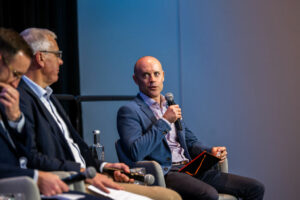
Alex Blauensteiner, Critical Infrastructure Protection and Resilience Mission, CSIRO
Moderator: Adam Stingemore, General Manager, Engagement and Communications, Standards Australia
Panelists:
- Alex Blauensteiner, Critical Infrastructure Protection and Resilience Mission, CSIRO
- Associate Professor Matthew French, Director Research Missions and Global Impact, Monash University
- Chris Locke, Deputy Secretary- Biosecurity and Compliance, Australian Department of Agriculture, Fisheries and Forestry
- Dr Cathy Robinson, Principal Research Scientist, CSIRO
The panel discussed the need for patient, inclusive, and collaborative approaches to co-design and co-delivery, particularly when tackling complex issues that require the involvement of diverse stakeholders and communities. The discussion’s key themes were effective communication, cultural sensitivity, and a focus on real impact.
Key takeouts:
- Challenges in Co-design and Co-delivery: Co-design and co-delivery can be challenging, especially when dealing with complex problems. Examples from various sectors were discussed, such as aluminium metal production and biosecurity, where finding consensus and shifting traditional practices can be time-consuming.
- Cultural and Indigenous Engagement: The importance of meaningful engagement, particularly with Indigenous communities and remote regions. Discussed was the need for culturally safe and remote-safe conversations where stakeholders from different backgrounds can collaborate effectively.
- Avoiding Fragmentation: The potential fragmentation when multiple organisations launch their own missions. The panel stressed the importance of building networks of networks and avoiding competition that could lead to further fragmentation.
- Key Features for Success: The panel highlighted several critical features for successful co-design and co-delivery, including shifting resources to those using them, addressing governance and roles as crucial components, and maintaining enthusiasm and optimism among partners throughout long-haul missions.
- Effective Communication: Communication was identified as a key factor in mission success. Clear and tailored messaging, both internally and externally, was emphasised to ensure that all stakeholders understand the goals and benefits of a mission.
- Collaboration vs. Competition: The importance of collaboration over competition. While acknowledging the need for specialised efforts, the panel stressed efforts should complement each other rather than duplicate, and resources should be prioritised effectively.
- Mission and Impact: Recognition that missions should focus on delivering meaningful impact to address real-world problems; the ultimate goal is to benefit the people for whom solutions are being developed.
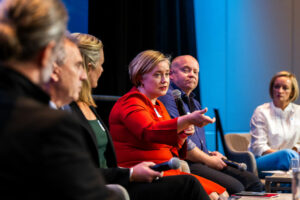
Cr Linda Scott, President, Australian Local Government Association
Moderator: Dr Jill Freyne – Deputy Chief Scientist, CSIRO
Panelists:
- Dr Peter Binks, Vice-President (Industry and External Engagement), Griffith University
- Heidi Hauf, Regional Sustainability Lead
Boeing Australia, New Zealand and South Pacific - Duncan Kerslake PSM, Project Manager, Deadly Innovation, Department of Tourism, Innovation and Sport (Queensland)
- Scott Riddle, AU/NZ Partnerships Manager and Lead on Digital Future Initiative Partnership Program, Google
- Cr Linda Scott, President, Australian Local Government Association
The panel discussion on “Industry and Community Partnerships” emphasised the pivotal role of collaborations and shared purpose in addressing significant challenges.
Key Takeaways:
- Shared Purpose: Collaborations thrive when anchored in a common purpose, especially when tackling issues too vast for a single entity. Establishing a distinct shared purpose is the cornerstone of successful partnerships.
- Community Engagement: Building authentic partnerships with Indigenous and Torres Strait Islander communities necessitates active listening and understanding of their needs and aspirations. Trust and dispelling preconceived notions are crucial.
- Pre-competitive Collaboration: As outlined by Boeing, Pre-competitive collaboration fosters innovation by bringing industry knowledge and research networks together to address shared challenges.
- Partnership Governance: There is a need for more robust partnership governance, with careful consideration of shared goals and values to avoid rushed or ill-informed collaborations.
- Local Government’s Role: Local governments serve as valuable trial sites for addressing complex issues, offering practical solutions to everyday problems. Their expertise should be leveraged in national planning.
- Long-Term Sustainability: Sustainable partnerships require alignment with organisational goals and transparency about key performance indicators (KPIs).
In conclusion, partnerships grounded in shared purpose, community engagement, and sustainability are essential for addressing Australia’s multifaceted challenges across industries, communities, and governments.
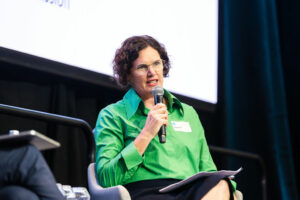
Associate Professor Cori Stewart, Chief Executive Officer, Advanced Robotics for Manufacturing Hub
Moderator: Associate Professor Cori Stewart, Chief Executive Officer, Advanced Robotics for Manufacturing Hub
Panelists:
- Dom English, First Assistant Secretary- Research, Australian Department of Education
- Anthony Murfett, Head of Division- Technology and Digital, Australian Department of Industry, Science and Resources
- Jane O’Dwyer, Chief Executive Officer, Cooperative Research Australia
- Professor Alex Robson, Deputy Chair, Productivity Commission
